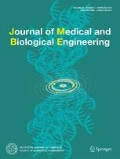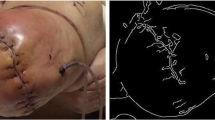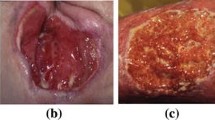Abstract
Automated identification of healing progression in lower limb wounds is an important clinical challenge since such wounds fail to heal in an orderly and timely manner. Selection of suitable target features and employment of appropriate analytical tool are critical for the precise monitoring of the healing progression through automated diagnostic method. The present study aims at automated detection of healing trend based on characteristics of epithelial rete pegs, which is considered as an important parameter for monitoring and hence healing progression of epithelial maturation. To this aim, the applicability of various segmentation methods namely, watershed, marker-controlled watershed, k-means clustering and active contour method and comprehensive characterization of rete-pegs are studied and compared. Among them active contour provided better performance in terms of non-linear objective assessments including performance metrics like-peak-signal-to-noise-ratio, processing speed and Mean Square Error. Further, support vector machine is trained for classification of the rete-peg features at different time points of clinically diagnosed non-healing wounds treated with a specific protocol. Kappa scoring tests inter-rater agreement between applied segmentation protocol and ground truth images. The overall accuracy of the system has been found to be 95%. It is thus concluded that with the aid of the proposed segmentation and classification method an automated detection system can be developed for precise monitoring of lower limb wound healing progression.






Similar content being viewed by others
References
Nunan, R., Harding, K. G., & Martin, P. (2014). Clinical challenges of chronic wounds: Searching for an optimal animal model to recapitulate their complexity. Disease Models & Mechanisms, 7(11), 1205–1213. https://doi.org/10.1242/dmm.016782.
Fauzi, M. F. A., Khansa, I., Catignani, K., et al. (2015). Computerized segmentation and measurement of chronic wound images. Computers in Biology and Medicine, 60, 74–85. https://doi.org/10.1016/j.compbiomed.2015.02.015.
Papazoglou, E. S., Zubkov, L., Mao, X., Neidrauer, M., Rannouy, N., & Weingarten, M. S. (2010). Image analysis of chronic wounds for determining the surface area. Wound Repair and Regeneration, 18(4), 349–358.
Frykberg, R. G., & Banks, J. (2015). Challenges in the treatment of chronic wounds. Advances in Wound Care, 4(9), 560–582. https://doi.org/10.1089/wound.2015.0635.
Loizou, P., Kasparis, T., Mitsi, O., & Polyviou, M. (2012). Evaluation of wound healing process based on texture analysis. In Proceedings of IEEE international conference on bioinformatics and bioengineering (pp. 709–714).
Engstorm, O. (2015). Altering the size of skin micrografts affects the healing quality of cutaneous wounds. Degree Project, Uppsala University.
Evans, N. D., Oreffo, R. O., Healy, E., Thurner, P. J., & Man, Y. H. (2013). Epithelial mechanobiology, skin wound healing, and the stem cell niche. The Journal of the Mechanical Behavior of Biomedical Materials, 28, 397–409.
Seyhan, T. (2011). Split-thickness skin grafts. In M. Spear (Ed.), Skin grafts—Indications, applications and current research. London: InTechOpen. ISBN 978-953-307-509-9.
Polito, D. B., Sato, S., Ritman, G., Mota, L. F., & Caffesse, R. G. (2001). Computer assisted image analysis methods for evaluation of periodontal wound healing. The Brazilian Dental Journal, 12(3), 167–172.
Song, B., & Sacan, A. (2012). Automated wound identification system based on image segmentation and artificial neural networks. In IEEE international conference on bioinformatics and biomedicines (pp. 619–622).
Jadhav, A. S., & Marathe, S. P. (2015). Recurrent idiopathic gingival fibromatosis with generalized aggressive periodontitis: A rare case report. Journal of Indian Society of Periodontology, 19(1), 93–95.
Mueller, J., Fu, H. L., Mito, J. K., et al. (2015). A quantitative microscopic approach to predict local recurrence based on in vivo intraoperative imaging of sarcoma tumor margins. International Journal of Cancer, 137(10), 2403–2412. https://doi.org/10.1002/ijc.29611.
Wang, L., Li, C., Sun, Q., Xia, D., & Kao C. Y. (2008). Brain MRI image segmentation using local and global intensity fitting active contours/surfaces. In Proceedings of medical image computing and computer aided intervention. Lecture notes in computer science (Vol. 5241, Part I, pp. 384–392). Berlin: Springer.
Jadhav, A. S., Banerjee, S., Dutta, P. K., et al. (2006). Quantitative analysis of histopathological features of precancerous lesion and condition using image processing technique. In IEEE international symposium on computer-based medical systems (pp. 231–236).
Serrano, C., Acha, B., Gomez, T. C., Acha, J. I., & Roa, L. M. (2005). A computer assisted diagnosis tool for the classification of burns by depth of injury. Burns, 31(3), 275–281. https://doi.org/10.1016/j.burns.2004.11.019.
Wannous, H., Treuillet, S., & Lucas, Y. (2007). Supervised tissue classification from color images for a complete wound assessment tool. In Proceedings of the 29th annual international conference of IEEE-EMBS, Engineering in Medicine and Biology Society (EMBC’07), pp. 6031–6034, August 2007.
Nayak, R., Kumar, P., & Galigekere, R. R. (2009). Towards a comprehensive assessment of wound-composition using color-image processing. In Proceeding of the IEEE international conference on image processing (ICIP’09) (pp. 4185–4188). https://doi.org/10.1109/icip.2009.5414527.
Kumar, K. S., & Reddy, B. E. (2014). Wound image analysis classifier for efficient tracking of wound healing status. Signal & Image Processing: An International Journal (SIPIJ), 5(2), 15–27. https://doi.org/10.5121/sipij.2014.5202.
Kumar, K. S., & Reddy, B. E. (2013). Digital analysis of changes in chronic wounds through image processing. International Journal of Signal Processing, Image Processing and Pattern Recognition, 6(5), 367–380. https://doi.org/10.14257/ijsip.2013.6.5.32.
Briskillal, C. D., & Kumar, K. M. (2014). Assessment and analysis on color image classification techniques of dermatological ulcers. International Journal of Advanced Research in Electronics and Communication Engineering (IJARECE), 3(11), 1440–1447.
Gonsalves, A., Machado, R., Michael, G., & Yadav, O. (2015). Comparative evaluation of thresholding and segmentation algorithms. International Journal of Computer Science and Information Technology (IJCSIT), 6(2), 1107–1110.
Wang, L., Pederson, P. C., et al. (2015). An automatic assessment system of diabetic foot ulcers based on wound area determination, color segmentation, and healing score evaluation. Journal of Diabetes Science and Technology, 10(2), 421–428. https://doi.org/10.1177/1932296815599004.
Turkki, R., Linder, N., Kovanen, P. E., Pellinen, T., & Lundin, J. (2016). Identification of immune cell infiltration in hematoxylin-eosin stained breast cancer samples: Texture-based classification of tissue morphologies. SPIE Proceedings. https://doi.org/10.1117/12.2217040.
Itoiz, M. E. (2002). FA Carranza (2002) The Gingiva. In M. G. Newman, H. H. Takei, & F. A. Carranza (Eds.), Carranza’s clinical periodontology (9th ed., pp. 204–228). Philadelphia, PA: W.B. Saunders Company.
Krishnan, M. M. R., Venkatraghavana, V., Rajendra, U., Pal, M., Paul, R. R., Min, L. C., et al. (2012). Automated oral cancer identification using histopathological images: A hybrid feature extraction paradigm. Micron, 43, 352–364. https://doi.org/10.1016/j.micron.2011.09.016.
Sood, A., Granick, M. S., & Tomaselli, N. L. (2014). Wound dressings and comparative effectiveness data. Advances in Wound Care, 3(8), 511–529. https://doi.org/10.1089/wound.2012.0401.
Gonzalez, R. C., & Woods, R. E. (2013). Digital image processing (3rd ed.). Upper Saddle River, NJ: Pearson. ISBN 978-81-317-2695-2.
Jayaraman, S., Esakkirajan, S., & Veerakumar, T. (2009). Digital image processing (17th ed.). New Delhi: McGraw Hill Education. ISBN 978-0-07-014479-8.
Kaur, A., & Verma, A. (2013). The marker-based watershed segmentation—A review. International Journal of Engineering and Innovative Technology (IJEIT), 3(3), 171–174.
Sonka, M., Hlavac, V., & Boyle, R. (2014). Image processing and analysis and machine vision (3rd ed.). Stamford, CT: CENGAGE Learning. ISBN 978-81-315-1883.
Jones, T. D., & Plassmann, P. (2000). An active contour model for measuring the area of leg ulcers. IEEE Transactions on Medical Imaging, 19(12), 1202–1210.
Zhu, S., & Gao, R. (2016). A novel generalized gradient vector flow snake model using minimal surface and component -normalized method for medical image segmentation. Biomedical Signal Processing and Control, 26, 1–10.
Haasdonk, B. (2005). Feature space interpretation of SVMs with indefinite kernels. IEEE Transactions on Pattern Analysis and Machine Intelligence, 27(4), 482–492.
Yadav, S. K., Kumar, R., & Dubey, P. K. (2013). Implementation and comparisons of different segmentation algorithm based on entropy and energy. International Journal of Scientific Research Engineering & Technology (IJSRET), 2(5), 279–285.
Zhang, H., Fritts, J. E., & Goldman, S. A. (2004). An entropy-based objective evaluation method for image segmentation. Proceedings of SPIE—The International Society for Optical Engineering, 5307, 38–49. https://doi.org/10.1117/12.527167.
Kaushik, P., & Sharma, Y. (2012). Comparison of different image enhancement techniques based upon PSNR & MSE. International Journal of Applied Engineering Research, 7(11), 2010–2014.
Huestis, S. (2014). Sensitivity and specificity. In F. R. Volkmar (Ed.), Encyclopedia of autism spectral disorder (pp. 2761–2762). Cham: Springer.
Pandya, K., Bulsari, S., & Sinha, S. (2014). SPSS in simple steps. New Delhi: KOGENT Learning Solutions. ISBN 978-93-5004-251-9.
McHugh, M. L. (2012). Interrater reliability: The kappa statistic. Biochemia Medica, 22(3), 276–282.
Unnikrishnan, R., Pantofaru, C., & Hebert, M. (2005). A measure for objective evaluation of image segmentation algorithms. In Workshop on Empirical evaluation methods in computer vision and pattern recognition (CVPR ‘05), June 2005.
Pal, R., Yang, J., Ortiz, D., Qiu, S., Resto, V., McCammon, S., et al. (2015). In-vivo nonlinear optical microscopy (NLOM) of epithelial-connective tissue interface (ECTI) reveals quantitative measures of neoplasia in hamster oral mucosa. PLoS ONE. https://doi.org/10.1371/journal.pone.0116754.
Usui, M. L., Mansbridge, J. N., Carter, W. G., Fujita, M., & Olerud, J. E. (2008). Keratinocyte migration, proliferation, and differentiation in chronic ulcers from patients with diabetes and normal wounds. Journal of Histochemistry and Cytochemistry, 56(7), 687–696.
Dale, B. A., Salonen, J., & Jones, A. H. (1990). New approaches and concepts in the study of differentiation of oral epithelia. Critical Reviews in Oral Biology and Medicine, 1, 167–190.
Shetty, S., & Gokul, S. (2012). Keratinization and its disorders. Oman Medical Journal, 27(5), 348–357. https://doi.org/10.5001/omj.2012.90.
Pal, R., Shilagard, T., Yang, J., Villarreal, P., et al. (2016). Remodeling of the epithelial-connective tissue interface (ECTI) in oral epithelial dysplasia as visualized by noninvasive 3D imaging. Cancer Research, 76(16), 4637–4647. https://doi.org/10.1158/0008-5472.CAN-16-0252.
Nicholas, D., Oreffo, R. O. C., Healy, E., Thurner, P. J., & Man, Y. H. (2013). Epithelial mechanobiology, skin wound healing, and the stem cell niche. Journal of the Mechanical Behavior of Biomedical Materials, 28, 397–409. https://doi.org/10.1016/j.jmbbm.2013.04.023.
Barui, A., Banerjee, P., Das, R. K., Basu, S. K., Dhara, S., & Chatterjee, J. (2011). Immunohistochemical evaluation of p63, E-cadherin, collagen I and III expression in lower limb wound healing under honey. Evidence-Based Complementary and Alternative Medicine. https://doi.org/10.1155/2011/239864.
Dhanachandra, N., Manglem, K., & Chanu, Y. J. (2015). Image segmentation using k-means clustering algorithm and subtractive clustering algorithm. Procedia Computer Science, 54, 764–771. https://doi.org/10.1016/j.procs.2015.06.090.
Boonnuk, T., Srisuk, S., & Sripramong, T. (2015). Texture segmentation using active contour model with edge flow vector. International Journal of Information and Electronics Engineering, 5(2), 107–111. https://doi.org/10.7763/IJIEE.2015.V5.512.
Thampi, S. M., Bandyopadhyay, S., Krishnan, S., Li, K.-C., Mosin, S., & Maode, M. (2015). Advances in signal processing and intelligent recognition systems. In Proceedings of second international symposium on signal processing and intelligent recognition systems (SIRS-2015), 16–19 December 2015, Trivandrum, India.
Barui, A., Banerjee, P., Das, R. K., Dhara, S., & Chatterjee, J. (2010). Correlating optical biopsy with histopathology of wounds under topical intervention with honey. In IEEE International conference on systems in medicine and biology (ICSMB). https://doi.org/10.1109/ICSMB.2010.5735373.
Jayachandran, M., Rodriguez, S., Solis, E., Lei, J., & Godavarty, A. (2016). Critical review of noninvasive optical technologies for wound imaging. Advances in Wound Care (New Rochelle), 5(8), 349–359. https://doi.org/10.1089/wound.2015.0678.
Acknowledgements
Authors would like to acknowledge Mr. Westley Hayes for his valuable suggestions.
Author information
Authors and Affiliations
Corresponding author
Ethics declarations
Conflict of interest
The authors declared that they have no conflict of interest.
Electronic supplementary material
Below is the link to the electronic supplementary material.
Rights and permissions
About this article
Cite this article
Dey, S., Ray, A., Maiti, N.C. et al. Precise Segmentation and Classification of Epithelial Rete-Pegs Signature in Assessing Lower Limb Wound Healing Progression. J. Med. Biol. Eng. 39, 151–162 (2019). https://doi.org/10.1007/s40846-018-0442-6
Received:
Accepted:
Published:
Issue Date:
DOI: https://doi.org/10.1007/s40846-018-0442-6




